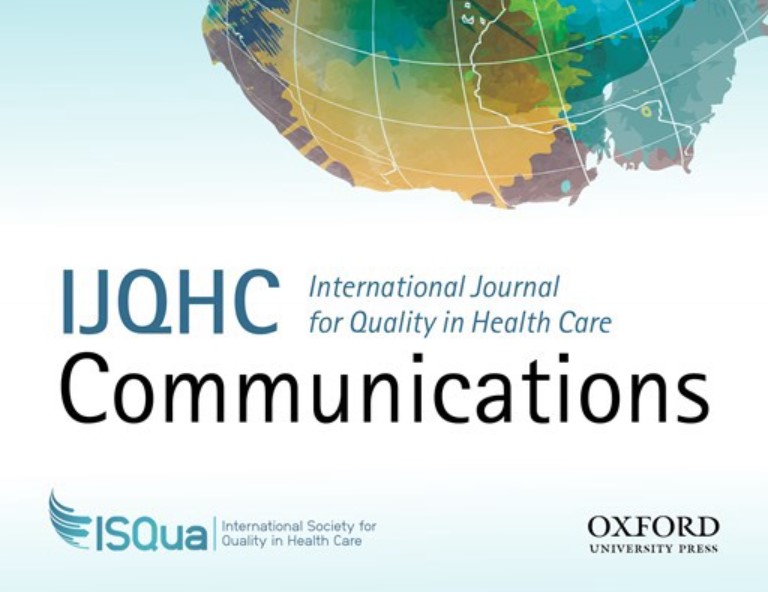There is a strong requirement for health care systems to simultaneously deal with the pandemic and provide safe, high-quality care.
Oxford Academic
International Society for Quality in Health Care and Oxford University Press
ISQUA — International Society for Quality in Health Care
Jeffrey Braithwaite, PhD
IJQHC Communications, Volume 1, Issue 1, 2021, lyab003,
Key Messages
- This article traces the progression of the COVID-19 pandemic from inception through to the present.
- Even before COVID-19, previous pandemics tested health services and had trouble keeping patients safe and providing quality care especially during the height of the crisis.
- There is a strong requirement for health care systems to simultaneously deal with the pandemic and provide safe, high-quality care.
- This means being resilient, and supporting the natural capacities health systems have to be adaptable, flexible, and responsive.
Abstract
Starting from first principles, logic tells us that providing quality care and making things safe for patients will be very challenging during any pandemic.
History backs this up, recording the inherent danger of widespread infections and concomitant burdens on healthcare systems, both before and after the A(H1N1) virus (‘the Spanish flu’) of 1918–20, which resulted in 50 million deaths.
The A(H2N2) ‘Asian flu’ of 1957–58 (1 million deaths), the A(H3N2) ‘Hong Kong flu’ of 1968–69 (1 million deaths), and the Ebola virus in seven countries of West Africa over 2014–16 (11 000 deaths) all sorely tested health services.
In the case of coronavirus disease 2019 (COVID-19; SARS-CoV-2), the virus came on suddenly and, despite many health systems having workable pre-pandemic plans, took most countries by surprise, to the justifiable frustration of the World Health Organization (WHO), public health practitioners, infectious disease specialists, and community activists.
The situation worsened rapidly, and planning often did not keep up. In response to pandemic-induced pressures, policymakers became reactive [ 1].
- Some politicians emphasized politics over good governance.
- Others contended, in a false dichotomy, that protecting the economy was more important than tackling the pandemic, when it was clear that both were important-and intertwined.
Without effectively addressing COVID-19, a country’s economy would rapidly deteriorate-or even become non-functional.
Meanwhile, the quality of care suffered. Whether prepared or not, the virus stretched some health systems to breaking point. There were reports from many countries of wards and intensive care units being overwhelmed. Available resources were deployed away from usual care to the surge in new cases. Normal quality and safety activities took a back seat in the face of rapidly accelerating disease transmission trends.
The downstream consequence of the prioritization of COVID by health systems is that many routine, non-COVID-19 patients have failed to receive appropriate care.
- Out of fear, lockdown restrictions, or insufficient availability of staff and resources at health facilities, many patients stayed away from emergency departments; others missed their scheduled check-up, screening, test, or procedure.
- Others could not be admitted or had delayed or rushed care-the individual or population effects of which have yet to play out. In the case of cancer patients, for example, there are legitimate and very real concerns for the lethal outcomes that will result from lack of timely treatment [ 2].
The downstream consequence of the prioritization of COVID by health systems is that many routine, non-COVID-19 patients have failed to receive appropriate care.
Some countries, which responded more rapidly and comprehensively, exhibited their resilience [ 3, 4] under pressure.
One pointed question we must raise when thinking about quality of care globally during COVID-19 concerns the differential way the pandemic was tackled.
The ’40 health systems, COVID-19 study’ (40HS, C-19) [ 5], reporting on data gathered in March and April of 2020 and published in the International Journal for Quality in Health Care ( IJQHC), analyzed three dimensions of tackling the pandemic. These were
- initial preparedness (labelled government ‘capacity to respond’);
- ‘stringency measures’ put in place such as quarantine, social isolation, mask wearing and the like; and
- ‘testing’, either broadly based, across the whole community, or narrowly based, targeting specific groups, mainly frontline staff and the elderly in residential aged care facilities.
The study found that broad-based testing was the key to handling the pandemic.
- Widespread testing means that people throughout a community know, or can find out, their infectious status, and thus, their level of risk.
- If sufficient people are informed, most will act appropriately and self-isolate or at the very least wear a mask.
- Transmission will tend to be mitigated.
- Quality care can then be provided to all patients under more normalized arrangements.
That is what has tended to happen in countries with effective testing regimes [ 5, 6].
Another article published early in the life history of the current pandemic in IJQHC was a survey administered in May-July 2020 across 97 countries, enrolling 1131 participants, mostly frontline staff [ 7].
Respondents were asked a range of questions, including whether infection control measures had been put in place; new clinical pathways for COVID-free patients had been designed and used; single rooms for isolated COVID-19 patients or dedicated wards for them had been established; and personal protective equipment, psychological support, and adequate training had been provided to clinicians allocated responsibility for acute care provision during the pandemic.
While most respondents reported good progress by mid-2020 on all these measures, significant differences were found across WHO regions, individual countries or provinces, and between health districts or counties [ 7].
There are now multiple other studies and much data available such as from the WHO ( https://www.who.int/emergencies/diseases/novel-coronavirus-2019), Our World in Data ( https://ourworldindata.org/), and the Johns Hopkins COVID-19 dashboard ( https://gisanddata.maps.arcgis.com/apps/opsdashboard/index.html#/bda7594740fd40299423467b48e9ecf6).
This pool of information has facilitated understanding, especially for the benefit of senior decision-makers, of how the pandemic is being handled internationally.
But politicians, Ministries, and upper-echelon policymakers have tended to focus on the management of the pandemic itself, rather than the quality of care and safety of patients per se.
Dealing with quality of care and patient safety is in times of national emergency typically a local rather than a country-wide issue.
But politicians, Ministries, and upper-echelon policymakers have tended to focus on the management of the pandemic itself, rather than the quality of care and safety of patients per se.
Dealing with quality of care and patient safety is in times of national emergency typically a local rather than a country-wide issue.
Meanwhile, as of April 2021, there are 128 265 articles referencing the term ‘COVID-19’ in PubMed.
This single data point is amazing considering the term did not exist until it was first coined by WHO on 11 February 2020.
That there has been so much written by way of commentary, and so many pandemic studies conducted in that relatively short period of time, is a testament to the priority this has been given by the research community.
The literature is fast moving, but by now, there are some informative studies beyond those already mentioned, beyond research about vaccines, and beyond reporting on the mechanisms of the disease or the SARS-CoV-2 virus itself; new studies are now focusing on the quality of care.
For example, studies have been conducted on
- predicting risk of mortality amongst Turkish inpatients [ 8];
- using artificial intelligence to screen UK patients for COVID-19 using routine clinical data [ 9];
- making recommendations for keeping Italian surgical staff safe and to reduce their risk of acquiring the infection [ 10];
- considering how to reopen surgical services during the pandemic while keeping staff and patients safe [ 11];
- reporting how patients’ medications can be managed in low- and middle-income countries via community pharmacists when hospitals are overwhelmed [ 12];
- examining quality of care indicators in Catalonia, Spain, on primary care practices during lockdown [ 13];
- and investigating the impact of COVID-19 on the capacity of a healthcare trust in the UK to provide a safe cultural environment for patients and staff using a tool well known to quality specialists-the Safety Attitudes Questionnaire [ 14].
Notwithstanding the importance of this and other work on quality of care, extracting actionable information from these studies and others is not always easy. In the middle of 2020, WHO published a guide, Maintaining essential health services: operational guidance for the COVID-19 context [ 15], much of which speaks to providing quality of care in situ in the midst of the pandemic ( Table 1).
This helpful list is nevertheless difficult to implement rapidly.
Staines and colleagues [ 16] made an observation by way of response, arguing that over the time that the pandemic has been challenging health systems, there may have been a tendency to overlook the contribution that quality and safety staff could provide to support efforts.
This is especially so when caring environments had to be reorganized to cope with the immediacy of the accelerating numbers of infectious patients.
Staines et al. suggested that it was important not to fail to harness patient safety and quality of care personnel who had much to offer and who might otherwise be underutilized or even marginalized.
Their article was a plea for creating leverage and liberating expertise.
… it is important not to fail to harness patient safety and quality of care personnel who had much to offer and who might otherwise be underutilized or even marginalized.
This plea remains a sage reminder today. Staines and colleagues held that
- the skill set of patient safety and quality improvement among staff includes an ability to help strengthen the system, even while the pandemic is raging;
- a capacity to continue to engage with citizens, patients, and their families, acting as a bridge between higher-level task forces or working parties responsible directly for the pandemic;
- being able to continue the work of improving care and workflows while many things in healthcare change as a consequence of COVID-19;
- advocating for efforts to continue to focus on reducing harm and managing risk for both COVID-19 and non-COVID-19 patients;
- and expertise in supporting and expanding the learning system, capturing knowledge of opportunities to improve care over time when many other people (policymakers, managers and leaders, and clinical teams) are working directly on the myriad of unfolding events caused by the pandemic.
All in all, even during dire times when almost everything must be COVID-19 focused and everything else deemed non-urgent is de-prioritized, we ought to not neglect everyday care and the quality of care provided to all patients, whether virus affected or not.
Being adaptable, flexible, and responsive, with the capacity to multi-task-in short, being resilient-are crucial features of successful health systems [ 17–20].
Indeed, ameliorating harm and providing quality care during the pandemic are vitally important tasks if we are to heed healthcare’s worldwide mission to provide universal health coverage at a sufficiently high standard to all, while continuously improving care, even in times of crisis.
The International Society for Quality in Health Care, the WHO, and other major international bodies all play a role in this mission.
It is also a multifaceted goal to which everyone concerned with the quality of care should aspire.
Acknowledgements
My sincere appreciation goes to Mai Nguyen and Kelly Nguyen for their highly efficient assistance in the production of this paper.
SCOPUS author number
Data availability
No new data were generated or analysed in support of this research.
Conflict of interest
None declared.
References
See long version of the paper.
About the author
Jeffrey Braithwaite, PhD
International Society for Quality in Health Care, Dublin, Ireland
and Centre for Healthcare Resilience and Implementation Science, Australian Institute of Health Innovation, Macquarie University, Sydney, NSW, Australia
Originally published at https://academic.oup.com.
PDF version
TAGS: Quality improvement in Health Care beyond Pandemic; Lessons Learned; Resilient Health Systems;













